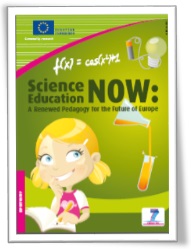[:es]
¿Qué es STEAM?
STEAM es el acrónimo de Science Technology Engineering Art Mathematics. Se trata de una integración del Arte en un enfoque de enseñanza basado en la interdisciplinaridad y aplicabilidad de los conocimientos de ciencias y matemáticas. Los proyectos y actividades propuestos bajo esa finalidad tienen como objetivo la aplicación del conocimiento científico y matemático en un contexto vinculado a la tecnología y la ingeniería. De esa forma, el acrónimo adecuado para este tipo de actividades es STEM (Science Technology Engineering Mathematics).
¿Por qué se concede gran importancia al enfoque STEM en la Unión Europea?
Desde la UE se considera la formación de técnicos y graduados en áreas científicas una necesidad para su futuro. En muchos países europeos, el número de graduados y técnicos especialistas en áreas científicas, matemáticas, tecnológicas y de ingeniería es claramente insuficiente para las necesidades de sus empresas e industrias. Con tal motivo, despertar el interés de los estudiantes europeos por las áreas STEM se convierte una prioridad para el futuro económico de la UE. Para conseguirlo, ha dedicado y dedica una gran cantidad de recursos y esfuerzos para conseguir integrar la STEM en las aulas preuniversitarias, contando con la colaboración del sector privado en muchos de sus proyectos (empresas tecnológicas, telecomunaciones, químicas, etc.)
Para ampliar la información, se pueden consultar los siguientes enlaces:
Informe del año 2007 que sentó las bases de la STEM como una prioridad de la UE
Portal que se hace eco de las recomendaciones de la UE en materia de Educación. Una de las tres “focus areas” de Schoolnet es la STEM. Incluye un gran número de enlaces a proyectos STEM financiados por la UE
Informe de 96 páginas en el que se analiza la situación en Europa e incide en las razones para que las STEM sean consideradas una prioridad en la educación europea.
[:en]
STEAM stands for Science Technology Engineering, Art and Mathematics.
It integrates art in a system based on interdisciplinarity and applicability of knowledge of science and mathematics teaching approach. Projects and activities proposed under this objective apply scientific and mathematical knowledge to technology and engineering. Thus, the appropriate acronym for this type of activity is STEM (Science Technology Engineering Mathematics).
Why is great importance attached to the STEM approach in the European Union?
The EU attaches the greatest importance to the training of technicians and graduates in scientific fields. In many European countries, the number of graduates in scientific and technical specialists, math, technology and engineering areas is clearly insufficient for the needs of their companies and industries. To stimulate the interest of European students in the STEM areas is a priority for the economic future of the EU. To achieve this, the EU has dedicated and devoted a lot of resources and efforts to integrate STEM into the pre-university classrooms. This has featured the collaboration of the private sector in many of these projects (technology companies, telecommunications, chemical, etc.).
For further information, please click on the following links:
This report studies initiatives which actively contribute to the development of interest in science and the involvement of young people in STEM.
It is a network of 30 European Ministries of Education. They aim to bring innovation in teaching and learning following the UE recommendations. One of the three focus areas of Schoolnet is STEM. Here you can find information about UE projects about STEM.
The report is the result of an analysis of country responses to a survey launched addressing recent, current or planned priorities, policies and initiatives aimed at improving the relevance and quality of STEM education to encourage more students to study and choose a career in the STEM field.
[:fi]
STEAM on lyhenne sanoista Science, Technology, Engineering, Art ja Mathematics.
Suomeksi STEAM tarkoittaa siis luonnontieteitä, teknologiaa, insinööritieteitä, taidetta ja matematiikkaa.
More information in English:
Projects and activities proposed under this objective apply scientific and mathematical knowledge to technology and engineering. Thus, the appropriate acronym for this type of activity is STEM (Science Technology Engineering Mathematics).
Why is great importance attached to the STEM approach in the European Union?
The EU attaches the greatest importance to the training of technicians and graduates in scientific fields. In many European countries, the number of graduates in scientific and technical specialists, math, technology and engineering areas is clearly insufficient for the needs of their companies and industries. To stimulate the interest of European students in the STEM areas is a priority for the economic future of the EU. To achieve this, the EU has dedicated and devoted a lot of resources and efforts to integrate STEM into the pre-university classrooms. This has featured the collaboration of the private sector in many of these projects (technology companies, telecommunications, chemical, etc.).
For further information, please click on the following links:
This report studies initiatives which actively contribute to the development of interest in science and the involvement of young people in STEM.
It is a network of 30 European Ministries of Education. They aim to bring innovation in teaching and learning following the UE recommendations. One of the three focus areas of Schoolnet is STEM. Here you can find information about UE projects about STEM.
The report is the result of an analysis of country responses to a survey launched addressing recent, current or planned priorities, policies and initiatives aimed at improving the relevance and quality of STEM education to encourage more students to study and choose a career in the STEM field.
[:]



